An Innovative Approach for Delamination of Solar Panels Using a Heated Metal Wire
Abstract
1. Introduction
2. Results
2.1. Test Results with Kanthal Round Wire
2.2. Test Results with Kanthal Wire with a Rectangular Cross-Section
3. Discussion
4. Materials and Methods
4.1. Test Samples
4.2. Proof-of-Concept Test Device and Other Tools
4.3. Experimental Setup
5. Conclusions
6. Patents
Author Contributions
Funding
Data Availability Statement
Conflicts of Interest
Abbreviations
| EVA | Ethylene-vinyl acetate |
| PV | Photovoltaic |
| GW | Gigawatts |
References
- Islam, I.; Jadin, M.S.; Al Mansur, A.; Kamari, N.A.M.; Jamal, T.; Lipu, M.S.H.; Azlan, M.N.M.; Sarker, M.R.; Shihavuddin, A.S.M. Techno-Economic and Carbon Emission Assessment of a Large-Scale Floating Solar PV System for Sustainable Energy Generation in Support of Malaysia’s Renewable Energy Roadmap. Energies 2023, 16, 4034. [Google Scholar] [CrossRef]
- Huang, W.-H.; Shin, W.J.; Wang, L.; Sun, W.-C.; Tao, M. Strategy and technology to recycle wafer-silicon solar modules. Sol. Energy 2017, 144, 22–31. [Google Scholar] [CrossRef]
- Franco, M.A.; Groesser, S.N. A Systematic Literature Review of the Solar Photovoltaic Value Chain for a Circular Economy. Sustainability 2021, 13, 9615. [Google Scholar] [CrossRef]
- Sah, D.; Chitra; Lodhi, K.; Kant, C.; Srivastava, S.K.; Kumar, S. Extraction and Analysis of Recovered Silver and Silicon from Laboratory Grade Waste Solar Cells. Silicon 2022, 14, 9635–9642. [Google Scholar] [CrossRef]
- International Energy Agency. Renewables 2022: Analysis and Forecast to 2027; International Energy Agency: Paris, France, 2023. [Google Scholar]
- Heath, G.A.; Silverman, T.J.; Kempe, M.; Deceglie, M.; Ravikumar, D.; Remo, T.; Cui, H.; Sinha, P.; Libby, C.; Shaw, S. Research and development priorities for silicon photovoltaic module recycling to support a circular economy. Nat. Energy 2020, 5, 502–510. [Google Scholar] [CrossRef]
- IRENA. Renewable Energy Statistics; IRENA: Abu Dhabi, United Arab Emirates, 2023. [Google Scholar]
- Ghosh, M.K.; Mansur, A.; Rifat, A.I.; Mollik, A.A.; Ghosh, A.K.; Soheb, M.; Islam, I.; Haq, M.A.U. The Prospect of Waste Management System for Solar Power Plants in Bangladesh: A Case Study. In Proceedings of the 2023 5th International Conference on Sustainable Technologies for Industry 5.0 (STI), Dhaka, Bangladesh, 9–10 December 2023; IEEE: Piscataway, NJ, USA; pp. 1–5. [Google Scholar] [CrossRef]
- Jung, B.; Park, J.; Seo, D.; Park, N. Sustainable System for Raw-Metal Recovery from Crystalline Silicon Solar Panels: From Noble-Metal Extraction to Lead Removal. ACS Sustain. Chem. Eng. 2016, 4, 4079–4083. [Google Scholar] [CrossRef]
- Akhter, M.; Al Mansur, A.; Islam, M.I.; Lipu, M.S.H.; Karim, T.F.; Abdolrasol, M.G.M.; Alghamdi, T.A.H. Sustainable Strategies for Crystalline Solar Cell Recycling: A Review on Recycling Techniques, Companies, and Environmental Impact Analysis. Sustainability 2024, 16, 5785. [Google Scholar] [CrossRef]
- Islam, M.T.; Iyer-Raniga, U.; Trewick, S. Recycling Perspectives of Circular Business Models: A Review. Recycling 2022, 7, 79. [Google Scholar] [CrossRef]
- Spooren, J.; Binnemans, K.; Björkmalm, J.; Breemersch, K.; Dams, Y.; Folens, K.; González-Moya, M.; Horckmans, L.; Komnitsas, K.; Kurylak, W. Near-zero-waste processing of low-grade, complex primary ores and secondary raw materials in Europe: Technology development trends. Resour. Conserv. Recycl. 2020, 160, 104919. [Google Scholar] [CrossRef]
- Gerold, E.; Antrekowitsch, H. Advancements and Challenges in Photovoltaic Cell Recycling: A Comprehensive Review. Sustainability 2024, 16, 2542. [Google Scholar] [CrossRef]
- Wang, T.-Y.; Hsiao, J.-C.; Du, C.-H. Recycling of materials from silicon base solar cell module. In Proceedings of the 2012 IEEE 38th Photovoltaic Specialists Conference (PVSC), Austin, TX, USA, 3–8 June 2012; IEEE: Piscataway, NJ, USA, 2012; pp. 2355–2358. [Google Scholar] [CrossRef]
- Huang, W.-H.; Tao, M. A simple green process to recycle Si from crystalline-Si solar cells. In Proceedings of the 2015 IEEE 42nd Photovoltaic Specialists Conference (PVSC), New Orleans, LA, USA, 14–19 June 2015; IEEE: Piscataway, NJ, USA, 2015; pp. 1–4. [Google Scholar] [CrossRef]
- Todorov, G.; Vasilev, H.; Kamberov, K.; Ivanov, T.; Sofronov, Y. Concept and Virtual Prototyping of Cooling Module for Photovoltaic System. In Proceedings of the 2021 6th International Symposium on Environment-Friendly Energies and Applications (EFEA), Sofia, Bulgaria, 24–26 March 2021; pp. 1–4. [Google Scholar] [CrossRef]
- Chen, P.-H.; Chen, W.-S.; Lee, C.-H.; Wu, J.-Y. Comprehensive Review of Crystalline Silicon Solar Panel Recycling: From Historical Context to Advanced Techniques. Sustainability 2024, 16, 60. [Google Scholar] [CrossRef]
- Savvilotidou, V.; Antoniou, A.; Gidarakos, E. Toxicity assessment and feasible recycling process for amorphous silicon and CIS waste photovoltaic panels. Waste Manag. 2017, 59, 394–402. [Google Scholar] [CrossRef] [PubMed]
- Dias, P.; Javimczik, S.; Benevit, M.; Veit, H.; Bernardes, A.M. Recycling WEEE: Extraction and concentration of silver from waste crystalline silicon photovoltaic modules. Waste Manag. 2016, 57, 220–225. [Google Scholar] [CrossRef]
- Latunussa, C.E.L.; Ardente, F.; Blengini, G.A.; Mancini, L. Life Cycle Assessment of an innovative recycling process for crystalline silicon photovoltaic panels. Sol. Energy Mater. Sol. Cells 2016, 156, 101–111. [Google Scholar] [CrossRef]
- Pagnanelli, F.; Moscardini, E.; Granata, G.; Atia, T.A.; Altimari, P.; Havlik, T.; Toro, L. Physical and chemical treatment of end of life panels: An integrated automatic approach viable for different photovoltaic technologies. Waste Manag. 2017, 59, 422–431. [Google Scholar] [CrossRef]
- Shin, J.; Park, J.; Park, N. A method to recycle silicon wafer from end-of-life photovoltaic module and solar panels by using recycled silicon wafers. Sol. Energy Mater. Sol. Cells 2017, 162, 38. [Google Scholar] [CrossRef]
- Granata, G.; Pagnanelli, F.; Moscardini, E.; Havlik, T.; Toro, L. Recycling of photovoltaic panels by physical operations. Sol. Energy Mater. Sol. Cells 2014, 123, 239–248. [Google Scholar] [CrossRef]
- Kim, Y.; Lee, J. Dissolution of ethylene vinyl acetate in crystalline silicon PV modules using ultrasonic irradiation and organic solvent. Sol. Energy Mater. Sol. Cells 2012, 98, 317–322. [Google Scholar] [CrossRef]
- Tammaro, M.; Rimauro, J.; Fiandra, V.; Salluzzo, A. Thermal treatment of waste photovoltaic module for recovery and recycling: Experimental assessment of the presence of metals in the gas emissions and in the ashes. Renew Energy 2015, 81, 103–112. [Google Scholar] [CrossRef]
- Chitra; Sah, D.; Lodhi, K.; Kant, C.; Saini, P.; Kumar, S. Structural composition and thermal stability of extracted EVA from silicon solar modules waste. Sol. Energy 2020, 211, 74–81. [Google Scholar] [CrossRef]
- Dias, P.; Schmidt, L.; Gomes, L.B.; Bettanin, A.; Veit, H.; Bernardes, A.M. Recycling waste crystalline silicon photovoltaic modules by electrostatic separation. J. Sustain. Metall. 2018, 4, 176–186. [Google Scholar] [CrossRef]
- Mulazzani, A.; Eleftheriadis, P.; Leva, S. Recycling c-Si PV Modules: A Review, a Proposed Energy Model and a Manufacturing Comparison. Energies 2022, 15, 8419. [Google Scholar] [CrossRef]
- Zeng, D.-W.; Born, M.; Wambach, K. Pyrolysis of EVA and its application in recycling of photovoltaic modules. J. Environ. Sci. 2004, 16, 889–893. [Google Scholar]
- Bombach, E.; Röver, I.; Müller, A.; Schlenker, S.; Wambach, K.; Kopecek, R.; Wefringhaus, E. Technical experience during thermal and chemical recycling of a 23 year old PV generator formerly installed on Pellworm island. In Proceedings of the 21st European Photovoltaic Solar Energy Conference, Dresden, Germany, 4–8 September 2006. [Google Scholar]
- Mapari, R.; Narkhede, S.; Navale, A.; Babrah, J. Automatic waste segregator and monitoring system. Int. J. Adv. Comput. Res. 2020, 10, 171. [Google Scholar] [CrossRef]
- Jo, S.; Kim, H.; Kim, Y. Solar Panel Recycling Apparatus and Method. Patent WO2020197231A1, 24 March 2020. [Google Scholar]
- Kim, Y.K. Apparatus for Recycling Solar Cell Module. Patent KR102154030B1, 9 September 2020. [Google Scholar]
- Takahashi, M.; Sakamoto, J.; Utsunomiya, K. Solar Battery Module Recycling Method. Patent JP2015110201A, 29 March 2017. [Google Scholar]
- Li, D.; Li, Y.; Li, Y.; Liu, D.; Chen, L.; Wang, Y. Method and Device for Disassembling and Recycling TPT Back Plate, EVA (Ethylene Vinyl Acetate Copolymer)/Battery Piece and Glass. Patent CN109530394B, 8 October 2021. [Google Scholar]
- Tsushima, T.; Ogasawara, S.; Kurihara, K.; Ibarada, N.; Tsuboi, N. Solar Battery Module Recycling Method and Solar Battery Module Recycling Device. Patent JP2018086651A, 7 December 2017. [Google Scholar]
- Li, X.; Dong, G.; Lai, W.; Wu, C.; Chen, Z.; Ma, C.; Yuan, B.; Liu, Y.; Wu, M.; Li, Y. Photovoltaic Module Recycling Method and System. Patent CN110571306A, 19 November 2021. [Google Scholar]
- Zheng, L.; Liang, H.; Ma, Y.; Ma, C.; Yang, Z.; Zhang, S.; He, Y.; Zhang, J.; Lei, M.; Liao, Q.; et al. Recovery Method and Device of Complete Glass Photovoltaic Module. Patent CN111790723A, 10 May 2024. [Google Scholar]
- Liu, J.; Qiao, Q.; Guo, Y.; Dong, L. EVA Heat Treatment Method of Waste Crystalline Silicon Solar Cell Module. Patent CN103978010A, 24 August 2018. [Google Scholar]
- Kushiya, K. Recycling Method of Solar Cell Module. Patent JP5574750B2, 20 August 2014. [Google Scholar]


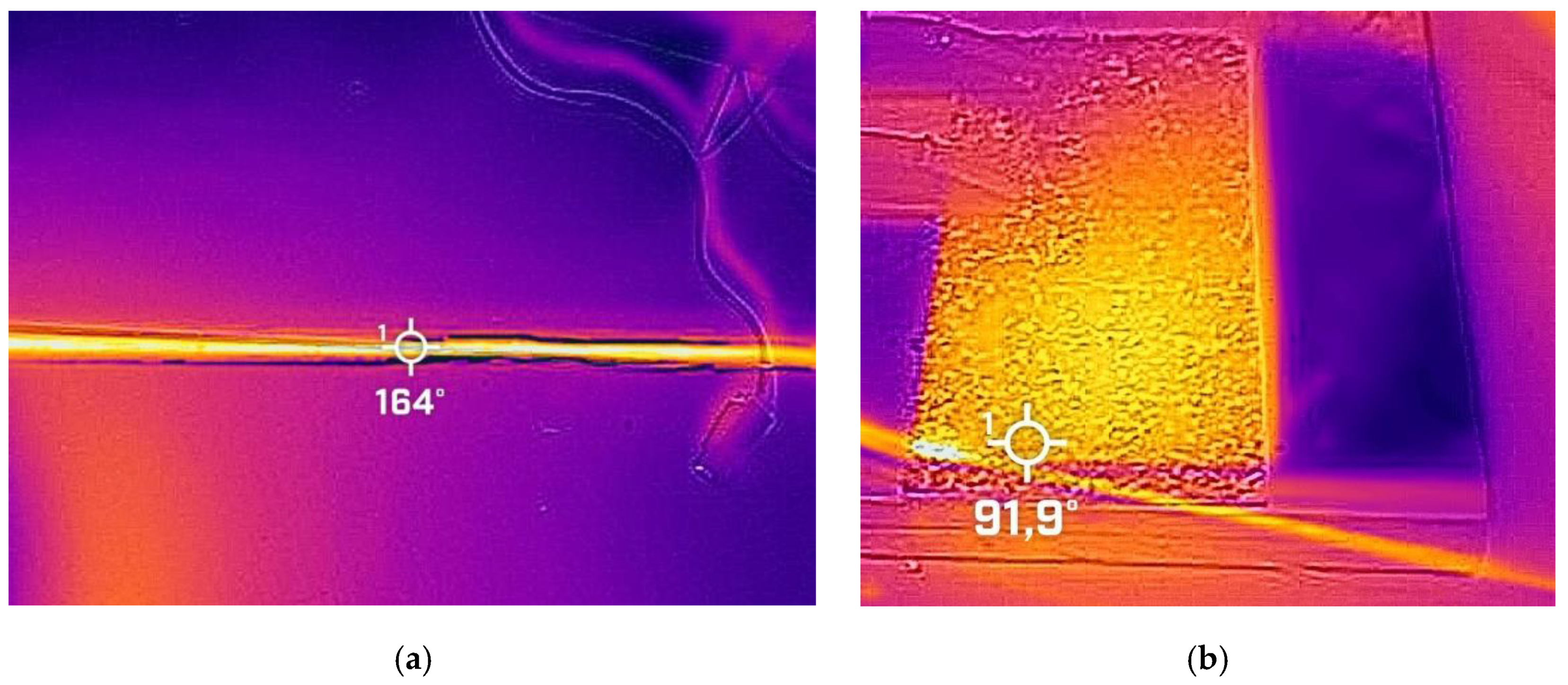
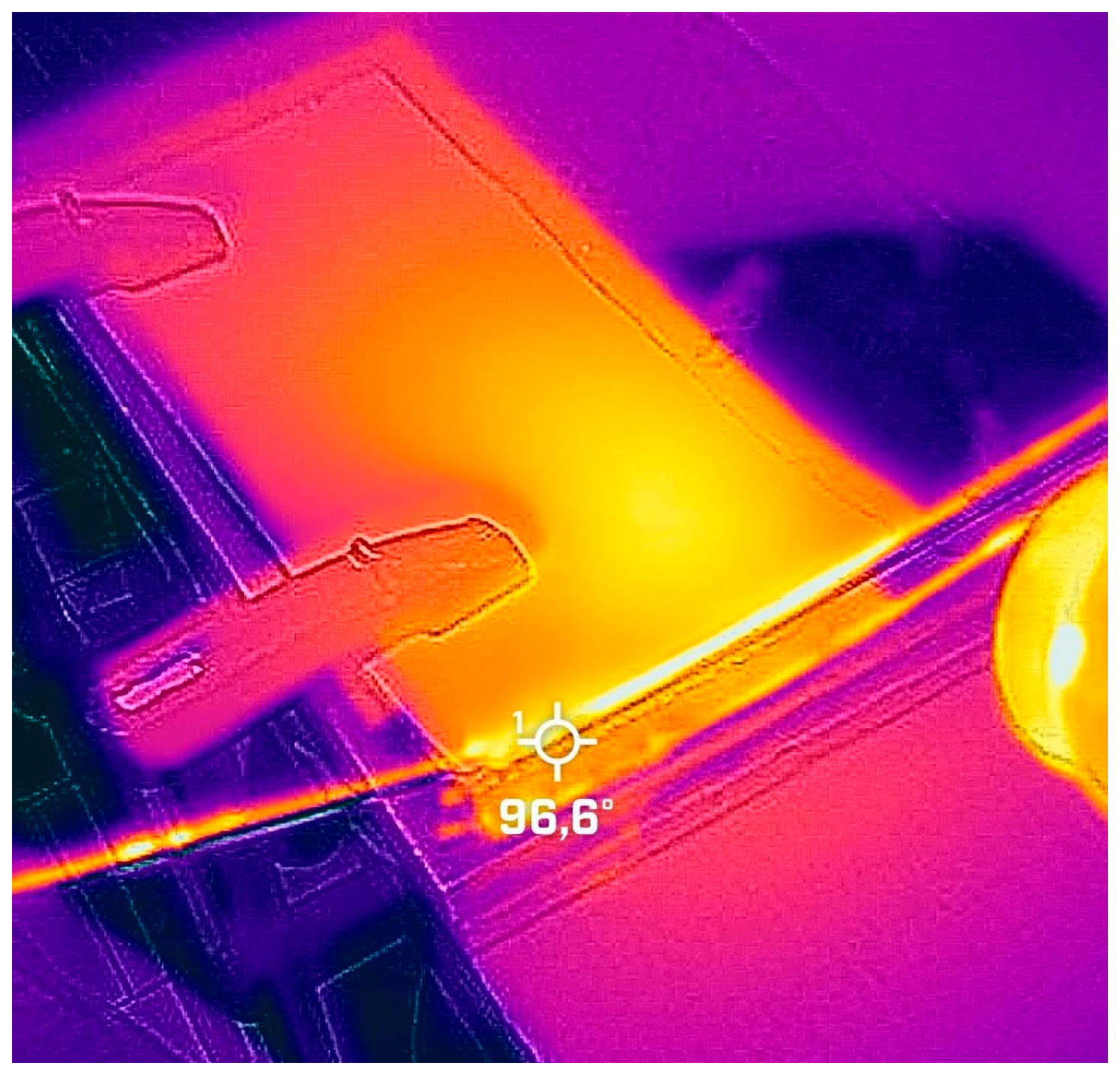
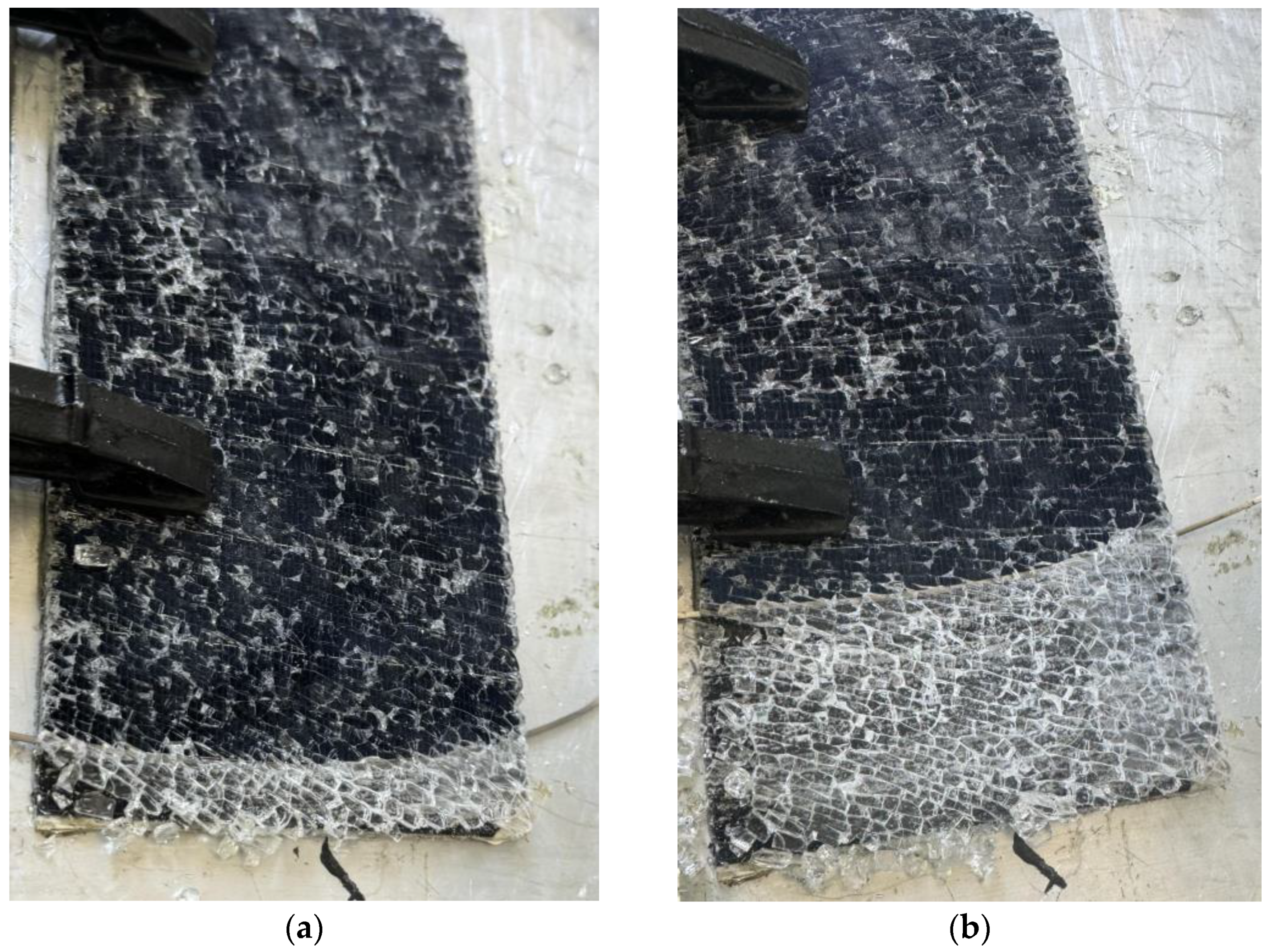


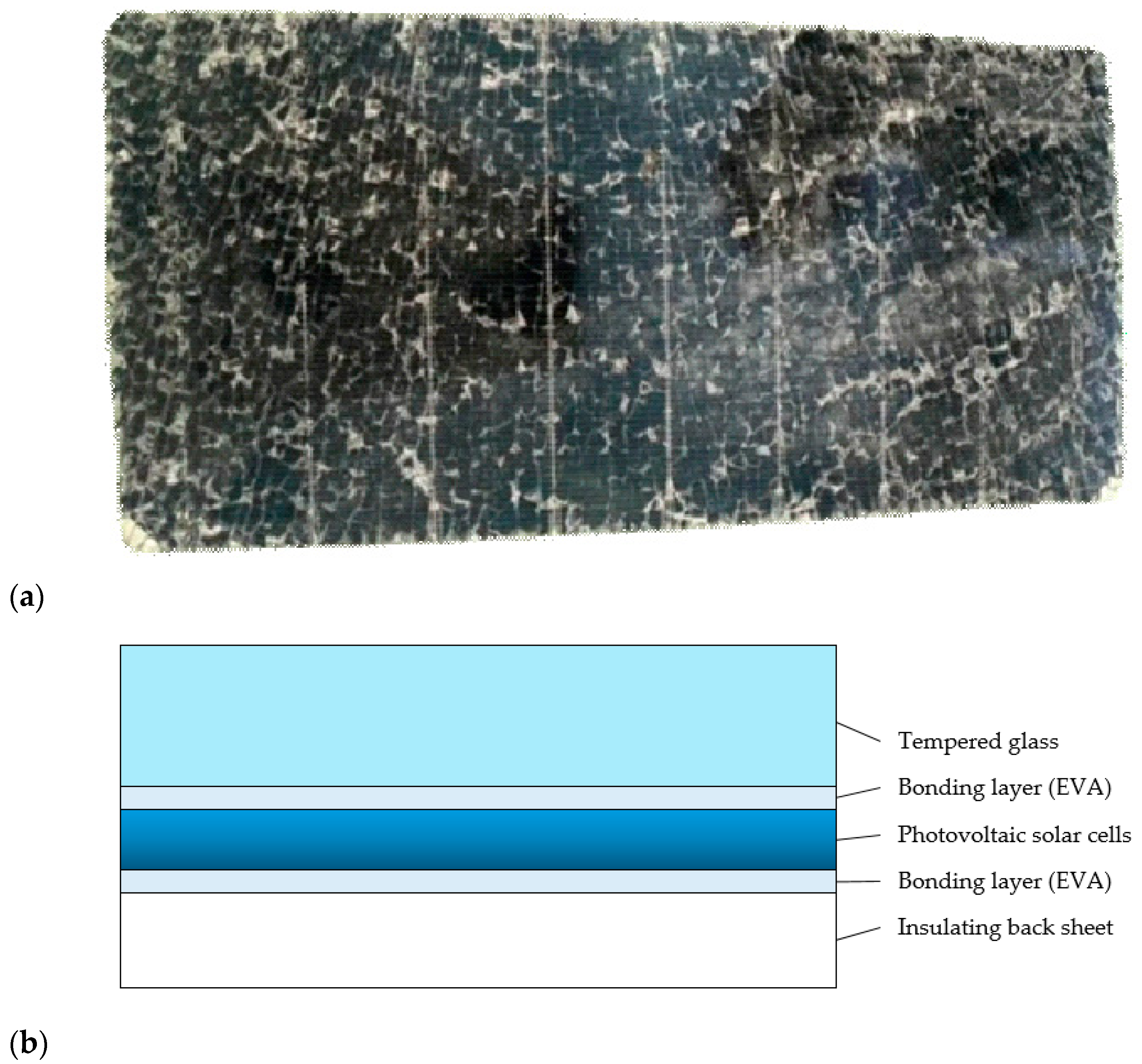
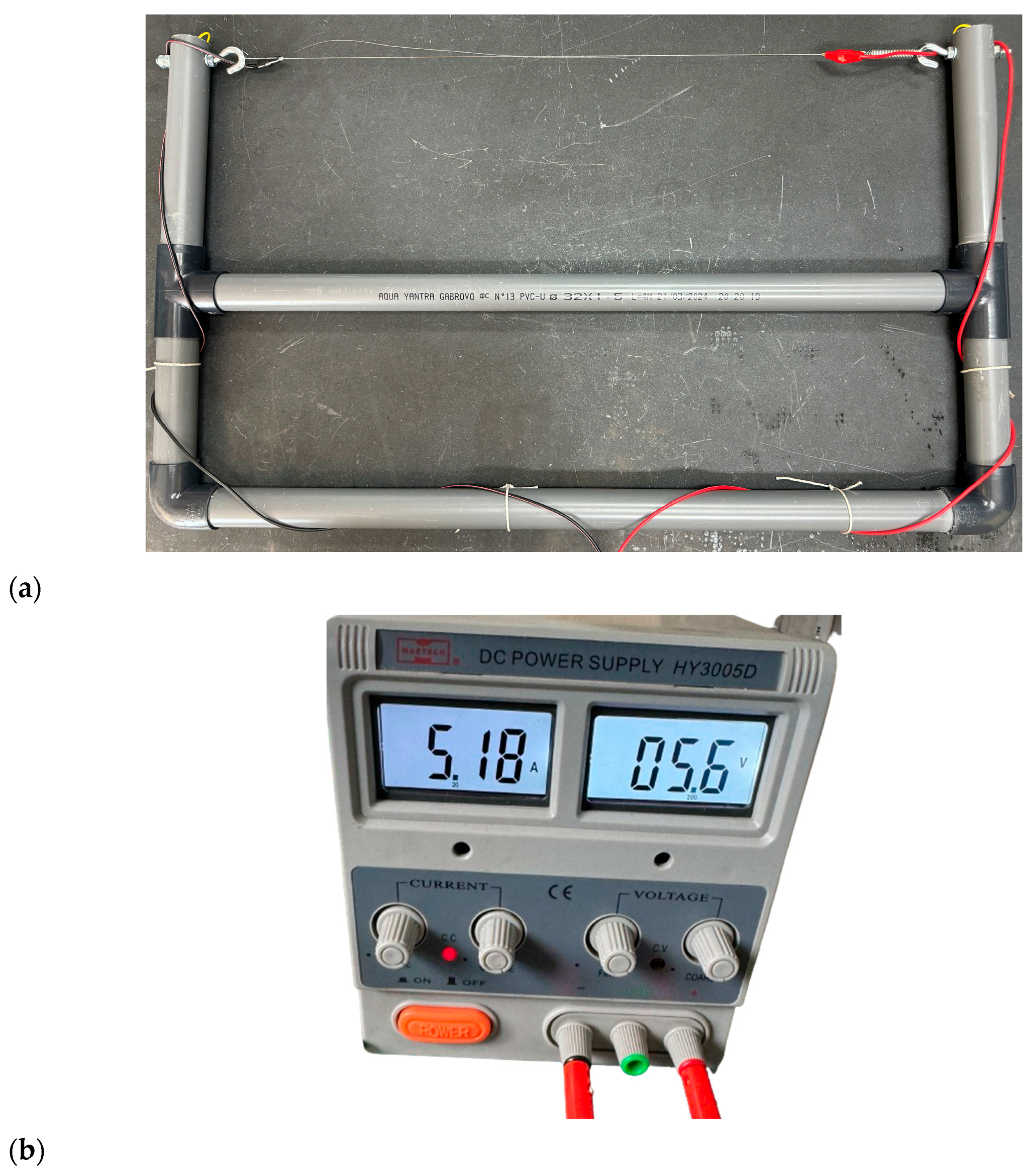
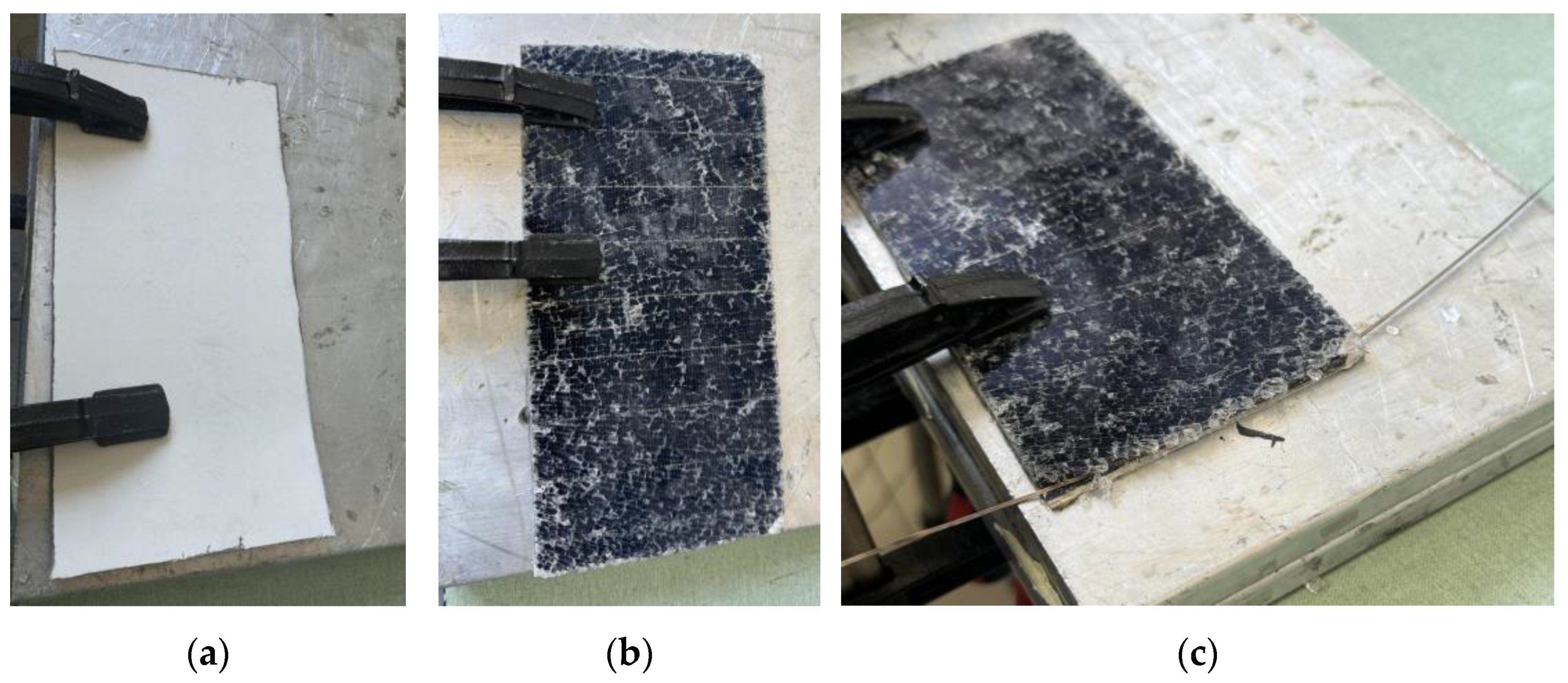
Disclaimer/Publisher’s Note: The statements, opinions and data contained in all publications are solely those of the individual author(s) and contributor(s) and not of MDPI and/or the editor(s). MDPI and/or the editor(s) disclaim responsibility for any injury to people or property resulting from any ideas, methods, instructions or products referred to in the content. |
© 2025 by the authors. Licensee MDPI, Basel, Switzerland. This article is an open access article distributed under the terms and conditions of the Creative Commons Attribution (CC BY) license (https://creativecommons.org/licenses/by/4.0/).
Share and Cite
Zagorski, M.; Dimitrov, K.; Kamburov, V.; Nikolov, A.; Stoichkov, K.; Stoyanova, Y. An Innovative Approach for Delamination of Solar Panels Using a Heated Metal Wire. Recycling 2025, 10, 104. https://doi.org/10.3390/recycling10030104
Zagorski M, Dimitrov K, Kamburov V, Nikolov A, Stoichkov K, Stoyanova Y. An Innovative Approach for Delamination of Solar Panels Using a Heated Metal Wire. Recycling. 2025; 10(3):104. https://doi.org/10.3390/recycling10030104
Chicago/Turabian StyleZagorski, Mihail, Konstantin Dimitrov, Valentin Kamburov, Antonio Nikolov, Kostadin Stoichkov, and Yana Stoyanova. 2025. "An Innovative Approach for Delamination of Solar Panels Using a Heated Metal Wire" Recycling 10, no. 3: 104. https://doi.org/10.3390/recycling10030104
APA StyleZagorski, M., Dimitrov, K., Kamburov, V., Nikolov, A., Stoichkov, K., & Stoyanova, Y. (2025). An Innovative Approach for Delamination of Solar Panels Using a Heated Metal Wire. Recycling, 10(3), 104. https://doi.org/10.3390/recycling10030104






